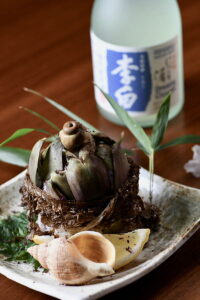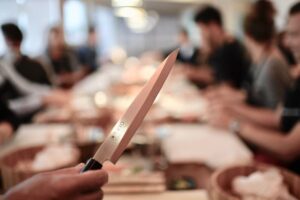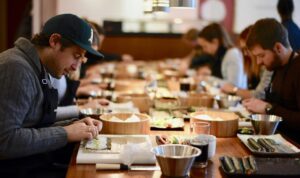At SUSHIYA we love the japanese cuisine and therefore operate the Restaurant sansaro. But we are not business-blind and prefer to visit other good Japanese restaurants even more than our own restaurant. When we recently once again another (and even highly praised by critics). Japanese restaurant in Munich, we were surprised to find that the Sashimi Moriawase seemed completely different than in our own restaurant.
While we were tasting it, we remembered how many times our chefs:inside Natsuko and Satomi explained to other junior chefs how to ideally arrange a sashimi.
When we inquired further on this topic, we quickly came up with the concept of moritsuke, which plays a very important role in Japanese cuisine. In Germany, however, it still seems to be completely unknown as a keyword. We have done some research and compiled all the information for you here.
What is Moritsuke?
Moritsuke (盛り付け) is the Japanese term for serving and arranging food on plates. Mori (盛り) means "to serve" and tsuke (付け) means "to adhere" and both together also mean to place food on a plate.
Moritsuke is a central component of Japanese cuisine. This is because Japanese people enjoy looking at the food with pleasure for a short time before eating it, tasting it first with their eyes and only then with their tongue, so to speak.
We also say that the eye eats with the food. But the idea of a specific arrangement of the food, from the smallest shapes on the plate, the sizes of the food components to the overall image of the plate is in Japan again in a completely different dimension and much more specific intention thought out and formalized.
The culinary pleasure of eating the same dish can actually vary significantly - depending on how well it is prepared.
Therefore, serving in Japan is considered "part of the cooking process" and requires knowledge of some artful techniques to be properly mastered.
Where does Moritsuke come from?
The history of Japanese culinary arts is very long. Formal cuisine, as served at the court of the Tenno, was strongly influenced by China, as were many other arts of the time until the 12th century. This affected both the methods of preparation and the style in which the dishes were served. The samurai then developed their own unique Japanese style, the Honzen-Ryōri, in the 14th century.
At that time, cooking utensils were also introduced, similar in shape to today's kitchen knives, and it came to the Connection of the art of cutting and seasoning. Japanese features such as the refined way of serving sashimi so that its beautiful grain is visible through the cut date from this period. For these reasons, Honzen-Ryōri is considered the origin of Japanese cuisine styles as we know them today.
Later, with the establishment of the tea ceremony and the associated cha-kaiseki, the unique Japanese concept of omotenashi - In short, the focus on the guest's experience - as an important element of the cuisine.
This is how the idea of "Moritsuke" was born in Japanese cuisine: to increase the pleasure for the guest by arranging the food with care and presenting it on the plate according to sophisticated basic ideas.
What are the main features of Moritsuke?
Easy to pick up and eat
First and foremost, of course, it is important to make it easy for the eater to pick up and eat the food.
It happens again and again that a chef wants to serve or present his food in a certain way so that it looks especially great - but the simple process of eating is not necessarily facilitated or supported by this.
Think of some elaborate breakfast sandwiches in modern cafes that do well on Instagram but are often not easy to eat. Or great hamburgers that may splatter in all directions when eaten and are clearly too big for the mouth. And even spaghetti and pizza are not automatically bite-sized on the plate by default, and certainly not automatically presented in bite-sized form directly by the chef.
In fact, it is surprisingly difficult to combine a beautiful presentation with ease of consumption. This is where the experience and skill of the chef come into their own.
In Japanese cuisine, kaiseki and à la carte dishes are usually prepared in individual portions for each person. Since most Japanese are right-handed and eat with chopsticks, when there are several dishes on a plate, the dishes on the front right are less voluminous and those on the back left are gradually more voluminous.
Tableware
When preparing a meal, the tableware on which the food is served also plays a crucial role.
As the famous gourmet and artist Kitaoji Rosanjin (北大路魯山人, March 23, 1883 - December 21, 1959) said, "Tableware is the kimono of food," and tableware is essential for serving a dish. Moreover, the tableware actually plays an important role in enhancing the taste, aroma and presentation of the food.
Japanese cuisine uses ceramic and porcelain dishes, lacquered bowls and a variety of vessel shapes made of different materials: Wood, plastic, glass, ceramics, porcelain, baskets made of bamboo, stones or shells - everything has a meaning, everything is used with thought.
In addition, Japanese cuisine is probably the only cuisine in the world that uses a combination of different dinnerware shapes such as bowls, soup bowls, and plates of different sizes and depths within just one meal. So, for example, two soups may be presented in two deliberately different soup bowls in one meal.
In addition, the seasonal colors, painted pottery and glassware remind us of the changing seasons not only through the seasonal ingredients, but also through the dishes themselves.
The meaning of the empty space
When serving food, the "empty space" (kukan, 空間) is very important.
It is said that when serving food, it looks nice if the amount of food is kept moderate in relation to the size of the bowl, leaving a margin of 30 % to 60 % or more.
Depending on the season, you can also use refined open spaces to create a feeling of freshness, freedom, lightness in the summer. And in contrast, you can arrange dishes more tightly in the winter to create a feeling of warmth, security, fullness.
Also, when serving soup in a bowl, it is said that it looks better if the amount of soup is only a maximum of 60 % to 70 % of the height of the bowl.
In this way, the chef can subtly direct the guest's perception.
Spiritual influence on the kitchen of harmony
A profound influence on Shintoism, the Japanese view of nature, and the way of life of the Japanese was the Ying-Yang philosophy of the five elements, which originated in China in the 6th and 7th centuries BC. It came to Japan during the Asuka period (710-794 BC) and is known there as the In-Yō Gogyo Shisō (陰陽五行思想).
This philosophy is also reflected in Japanese cuisine.
It divides all phenomena into the two elements "In and Yō" and the five elements of "Gogyō" and interprets the phenomena according to the combination of each element. Everything in "In" (陰, means shadow) and "Yō". (陽, means sunlight), and it is believed that the world exists by balancing these two elements.
Straight lines and curves blend into harmony
Based on this philosophy, in Japanese cuisine, square objects are considered "In" and round objects are considered "Yō", and the relationship between food and dishes is also considered to be one of In and Yō.
Since knives are not normally used when eating a Japanese meal, the food is cut into easy-to-eat pieces. Even when preparing these bite-sized pieces, the chef influences which pieces are round and which are square to be served to the guest. Following the concept of In-Yō harmony, it is said that a round plate should be used for square dishes such as steamed vegetables and a square plate should be used for dishes with a round cross-section such as makimono (sushi rolls).
The idea of creating harmony by balancing round and angular shapes is not an absolute rule, but it is an important element of moritsuke, which combines straight lines and curves in a perfect balance.
Number of dishes
In the In-Yō Gogyo Shisō, the odd numbers 1, 3, 5, 7 and 9 among the single-digit numbers are called "Yō numbers" and are considered lucky numbers - typical of Japanese culture to this day. The number of menu items at the Kaiseki and its predecessor, the Honzen-Ryōri, is therefore always an odd number, as is the variety of ingredients on the sashimi platters.
But why are nigirizushi traditionally often served as a pair of two? Firstly, because sushi chefs are considerate of their customers and say that two smaller pieces are easier to eat than one large piece, and secondly, because the Japanese prefer to serve two pieces in a row rather than just one.
It is said that today's nigirizushi, which can be eaten in a single bite, was not developed until the end of the Edo period (1603-1867).
In our restaurant, we know that many of our German guests still have a hard time with the different types of nigiri - and that's why you can order them individually with us. So it differs worldwide depending on the restaurant philosophy, whether you want to think traditionally in this question or offer the guest the greater flexibility in the selection.
Coloring
The five elements of the In-Yō Gogyō Shisō divide all things into five areas.
In Japanese cuisine, for example, there are mostly the flavors sweet, sour, spicy, bitter and salty and the preparation methods raw, boiled, grilled, fried and steamed.
The main colors in moritsuke are blue, red, yellow, white and black.
Typical ingredients used in Japanese cuisine are color-categorized as follows.
- Blue (in Japan, green is often referred to as blue): Leafy vegetables, peas like peas, beans, cucumbers, seaweed.
- Red: shrimp and other crustaceans, snapper, tuna, beef, carrots, tomatoes
- Yellow: eggs, pumpkin, chestnuts, sweet potatoes
- White: radish, turnip, white fish, squid, shellfish.
- Black: nori, kombu, hijiki and shitake
This use of five colors is practiced in the belief that cooking with these ingredients in mind will result in a healthy dish that is balanced in appearance, taste and nutritional value.
The 8 basic forms of Moritsuke
平盛り/Hira-Mori for Sashimi and Large Groups
"Hira" (平) means "flat", together with Mori makes Hira-Mori roughly "flat dressing"
Hira-mori is a relatively simple way of arranging food on a flat surface. This technique is often used when serving sashimi and other dishes on a large plate for a large group of guests.
It is important to avoid placing dishes with similar colors next to each other, and deliberately create gaps between some dishes to show off the individual dishes.
Also, when you look at things, your line of sight immediately shifts from the upper left to the lower right. Therefore, in most cases, it is best to start from the upper left corner and "flow" down to the lower right corner for a more relaxed look.
杉盛り/Sugi-Mori - cedar-shaped in small bowls.
Sugi-mori is one of the ways to serve salad, pickled food, thinly sliced sashimi, etc. in a small bowl. The bowl is arranged in the shape of a cedar tree (杉, sugi), which looks three-dimensional and elegant. So Sugi-Mori means this much like "cedar-oil dressing".
混ぜ盛り/Maze-Mori
Maze-Mori is derived from the Japanese word "mazeru", which means "to mix". Don't forget: the "z" is pronounced like a soft s, and of course it has nothing to do with the English "maze" (trap).
Maze-mori is a technique of serving dishes of different colors and shapes on one plate, which is basically based on sugi-mori. In Maze-Mori, however, different ingredients in different shapes and sizes (i.e. completely mixed) are arranged in a natural mountain shape.
Moritsuke of the Sugi-Mori and Maze-Mori form are also called "small sky and big bottom" (天小地大, Ten-shō-hi-dai) and are the most commonly used methods of serving in Japanese cuisine.
俵盛り/Tawara-Mori - stacking the bales
Tawara (俵) is a cylindrical bag made of woven straw or other material to hold rice or charcoal. A large pile of tawara signifies a good harvest and is considered a good omen.
This is basically a form of moritsuke in which evenly shaped round, balled and square bowls are stacked on top of each other like rice balls so that they form a nice triangular shape when served.
When it comes to sliced foods, the way they are presented can add variety to an inherently dense, compact dish.
重ね盛り/Kasane-Mori - piling up asymmetrical ingredients.
A food or dish is stacked at different angles and in different directions. It is used for dishes that are difficult to prepare with tawara-mori, such as grilled fish fillets, because the size and thickness of the fillets are different.
Kasane (重ね) means "to pile up".
寄せ盛り/Yose-Mori
Arrange several plates so that they nestle together in the center of the bowl. Unlike the Maze Mori, each dish has its own presence while nestled against each other.
Yoae (寄せ) means "to gather."
散らし盛り/Chirashimori
Several types of food are served scattered on a plate, each independently claiming its own shape, color and flavor. It is mainly used for appetizers. Even if the dishes are arranged far from each other, they should hang together as a single plate and convey a sense of movement. In Germany, of course, we know this term from the similarly named chirashizushi (or chirashi sushi, depending on which spelling is chosen).
流し盛り/Nagashi-Mori - typical arrangement of nigiri.
This term is often used for a type of dish of the same size, such as sashimi or ngiri sushi. The dishes are arranged so that they flow in the same direction. In nagashi-mori, the dishes are basically arranged so that the left side faces forward and the right side is tilted to the right. This moritsuke is also based on the movement of the human eye (from top left to bottom right).
Ten-Mori to round off
Ten (天) stands for heaven or the highest - the Japanese emperor, the Tenno is also written with this kanji. Ten-mori (天盛り) describes the rounding off or perfection of another mori, in which something else is put on top. For example, garnishing vinegared, cooked, or dressed dishes with a very small amount of fragrant ingredients such as kinome (the young leaves of Sanshō pepper), hari ginger (finely chopped ginger, hari (針) meaning needle), or chopped yuzu peel.
Seasonal ingredients are often used to add an accent to an existing mori. The chef is not only adding color and flavor, but also a subtle message for the knowledgeable guest. This is because the fresh accent may not change color until the dish reaches the customer, and it informs the guest of the chef's freshness and standards.
Conclusion: Moritsuke combines form and function when enjoying a Japanese meal
After Japanese cooks have devoted a great deal of effort to food using a wide variety of preparation techniques, the techniques of moritsuke, only briefly touched upon here, are then applied once again.
The rules by which food is prepared, ordered and presented are essentially shaped by a dualistic worldview that has informed the Japanese soul for hundreds of years and from which washoku, a cuisine of harmony, has emerged.
All this is done in the spirit of Omotenashi to make the meal especially tasty and an inner joy for the guest.
Good food brings joy, and an expertly prepared and arranged Japanese meal is certainly particularly suited to creating an inner joy.
Studies at Western research institutions such as Oxford University in the United Kingdom have also shown, That food tastes better when it is served in a suitably selected set of dishesThe same food is perceived differently in terms of taste due to the choice of tableware.
Even though the guest may not even notice, not know what moritsuke is or what principles Japanese chefs work by, the enjoyment of the meal can be significantly increased.
Any questions? Gladly!
We plan to add some photos to the article when we get a chance.
Until then - have we explained everything understandably so far? Are there any questions or other opinions? Write to us via our Contact form, we will take care of it!






